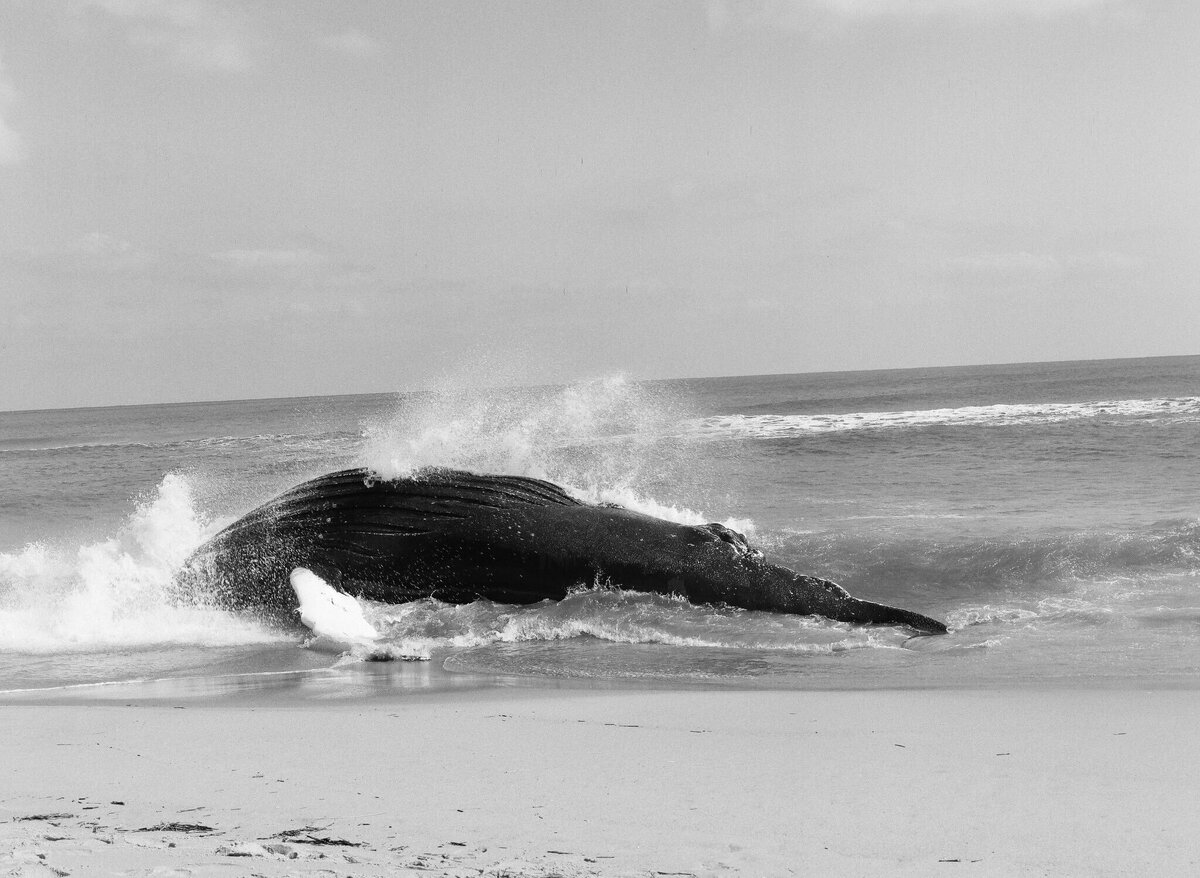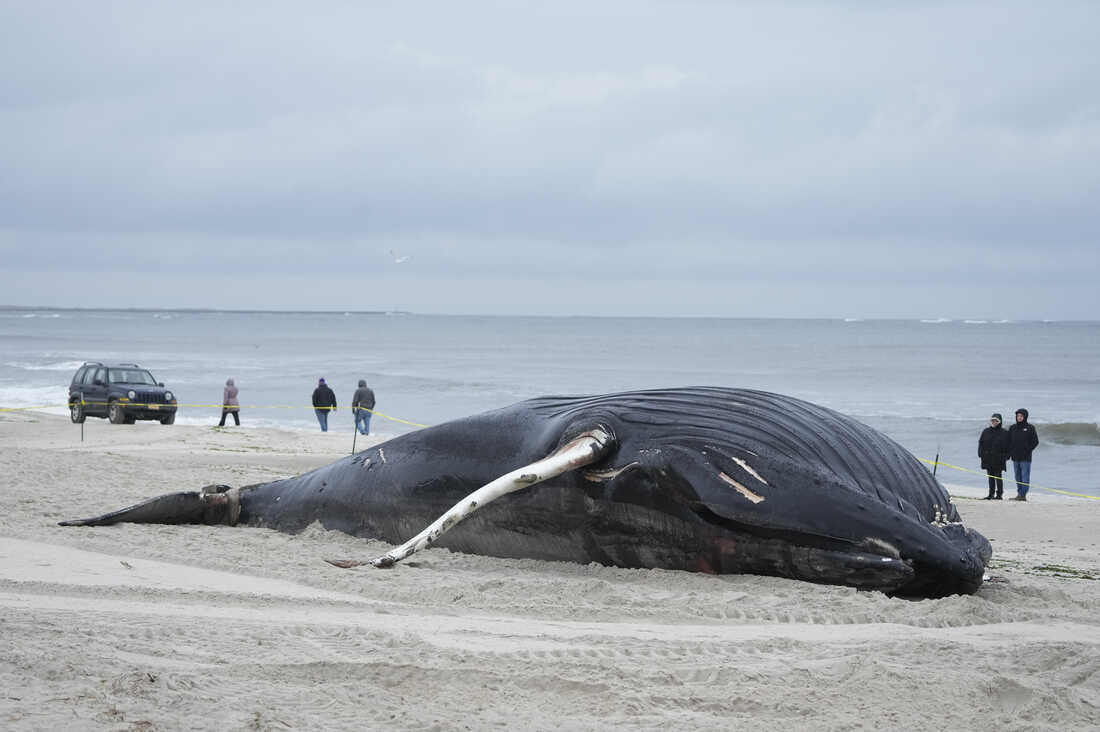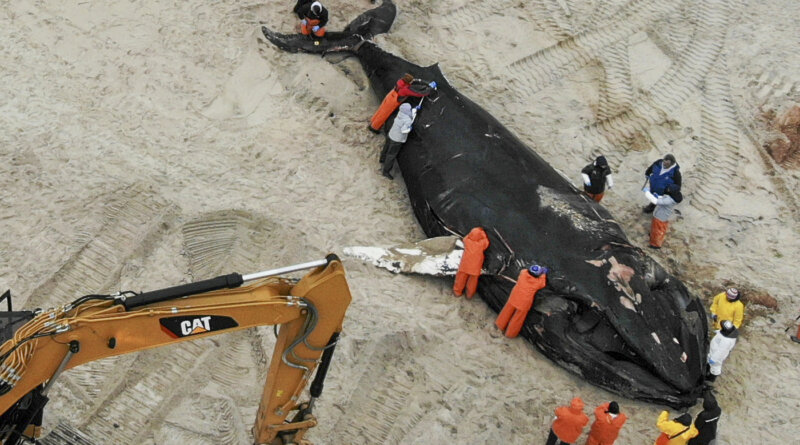Humpback whales keep washing up on the East Coast – here’s why : NPR

Pivot, the humpback whale stranded on the Assateague Island shoreline.
David Sexton
hide caption
toggle caption
David Sexton

Pivot, the humpback whale stranded on the Assateague Island shoreline.
David Sexton
David Sexton of Baltimore, Maryland was walking along the Assateague shoreline last February when he was alerted to a whale sighting a few hundred meters down.
“I looked out to the ocean, and I said: ‘Where is it?'”
The 30-ton, 15-year-old, female Humpback whale wasn’t in the ocean. The whale was lying dead on the beach, blocked by a caution tape. Sexton said he went home to investigate what could have caused the death of ‘Pivot’ the whale, often spotted in the Gulf of Maine.
Sexton wasn’t able to find a reason for the whale’s death.
Pivot is one of the 26 humpback whales strandings from Maine to Florida since last January according to According to the National Oceanic and Atmospheric Administration (NOAA). Whale strandings, or Cetacean strandings, occur when a whale is found dead on a shoreline, or alive, but unable to return to the water. The species typically lives up to 90 years, weighs 40 tons, and grows to an average of 60 feet.
Pivot’s cause of death is still unknown, but NOAA believes that vessel strikes, entanglement in fishing equipment and changing water temperatures are the biggest threats to the species.
This January, another juvenile whale washed ashore in Assateague
Hugh Hawthorne, superintendent of Assateague Island National Seashore, a national park service unit, said a second humpback whale washed up on Assateague Island on Jan. 16.
Like ‘Pivot,’ the whale that washed ashore on Jan. 20 was most likely a juvenile humpback whale, as Hawthorne said it was about 21 feet long and weighed about 15 to 20 tons.
“It shows evidence of being hit by a boat propeller,” Hawthorne told NPR, “It’s hard to say how long it will take before we get any word about what the cause of death was.”
The two whales that were washed up on the shore of Assateague are a fraction of the 180 Humpback whales that have been stranded or washed up on an east coast beach in the last seven years.
Boats, fishing nets, and algae can cause humpback whale strandings

Members of the Argentine Naval Prefecture and volunteers try in vein to rescue a stranded humpback whale in Mar del Plata, Argentina.
Pablo Hugo Funes/AP
hide caption
toggle caption
Pablo Hugo Funes/AP

Members of the Argentine Naval Prefecture and volunteers try in vein to rescue a stranded humpback whale in Mar del Plata, Argentina.
Pablo Hugo Funes/AP
Humpback whales are experiencing an “unusual mortality event” along the Atlantic coast because of the “elevated” number and inconsistent causes of death.
“We were seeing an increase in strandings throughout the region,” Mendy Garron, marine mammal emergency response coordinator for NOAA said. “And there are certain criteria we use to declare an unusual mortality event, you know, increases in stranding through time and space, unusual findings for cause of death … those kinds of things.”
Garron said a large amount of algae growing in water, along with human activities like vessels and fishing, have contributed to the deaths of Humpback whales in the past.
After the recent whale wash up on a Maryland shoreline, Republican Congressman Andy Harris (MD-01) called for the construction of offshore wind farms to stop.
Following the death of yet another whale, this time on Assateague Island, I am calling for an immediate MORATORIUM on windmill construction until it is definitively proven that this construction and geotechnical testing are NOT the cause of repeated whale deaths.
📸 Allen Sklar pic.twitter.com/KXgWMW8AHg
— Rep. Andy Harris, MD (@RepAndyHarrisMD) January 20, 2023
But Edward Hale, a professor at the School of Marine Science & Policy at the University of Delaware-Sea Grant, said wind farms were unlikely to contribute to the deaths of humpback whales.
“I don’t know that there is a significant amount of evidence to suggest that marine mammals are really especially affected by the production of electromagnetic fields,” Hale said. “I think there’s quantitative ways to analyze that before you point a finger at any one industry. I definitely think that that’s really premature to do so.”
More humpback whales may mean more strandings

People work around the carcass of a dead whale in Lido Beach, N.Y., Tuesday, Jan. 31, 2023.
Seth Wenig/AP
hide caption
toggle caption
Seth Wenig/AP

People work around the carcass of a dead whale in Lido Beach, N.Y., Tuesday, Jan. 31, 2023.
Seth Wenig/AP
The United States declared humpback whales an endangered species for the first time in 1970, under the ‘Endangered Species Conservation Act.’ Since then, the Humpback whale population has grown grew from 15,000 to nearly 85,000.
But this increased number of humpback deaths along the Atlantic coast has happened in tandem with significant population growth, and Garron said, an increased presence in the mid-Atlantic.
The species is likely to benefit from climate change effects like warming waters, Garron said, because the fish they eat become more abundant in warm water. At the same time, Humpbacks’ prey may leave them vulnerable to human interference.
“Some of the prey species that they do feed on come in fairly close to shore, Garron said. “So that can put them in areas where they’re overlapping with boat traffic or fishing gear, which may make them more vulnerable to those risks.”

People walk down the beach to take a look at a dead whale in Lido Beach, N.Y.
Seth Wenig/AP
hide caption
toggle caption
Seth Wenig/AP

People walk down the beach to take a look at a dead whale in Lido Beach, N.Y.
Seth Wenig/AP
Another humpback whale breaches Lido Beach, Long Island
A 40-year-old male Humpback known as ‘Luna’ was the latest to wash up on the east coast. He was stranded at Lido Beach in Long Island, New York, on Jan 30. A necropsy, or animal autopsy, revealed the 29,000 pound animal was struck by a vessel and died while ashore.
Humpback whales are still protected under the Marine Mammal Protection Act, which aims to protect marine animal populations from decline.
“We request that if you see an animal in distress or on the beach to call your local stranding organization, we do have a regional hotline number, it’s 866-755-6622,” Garron said. “We do want to encourage people to report those sightings of animals and of strandings to those locally trained responders.”
The audio version of the interview with Mendy Garron and Hugh Hawthorne was produced by Julie Depenbrock. The digital story was edited by Majd Al-Waheidi.





